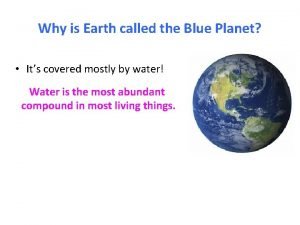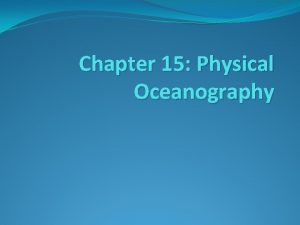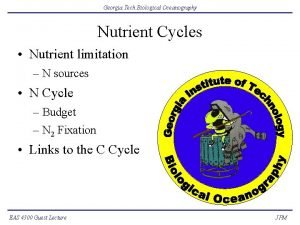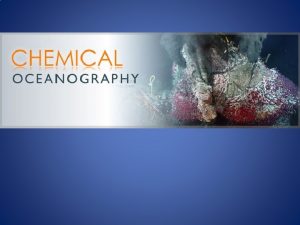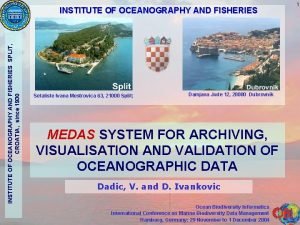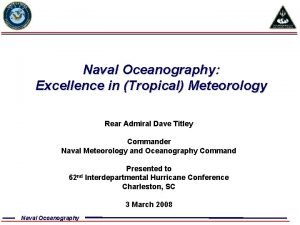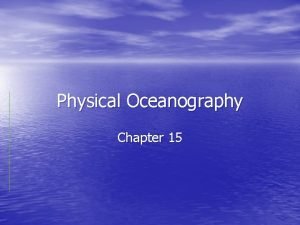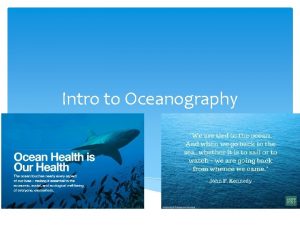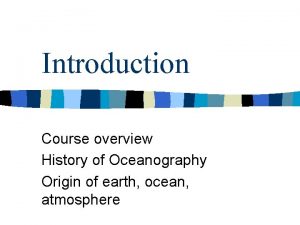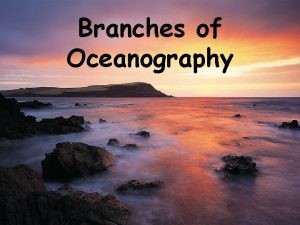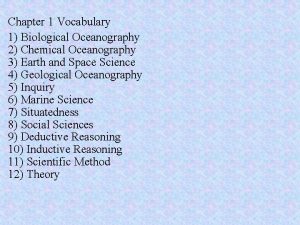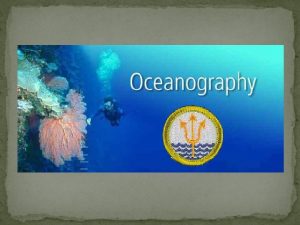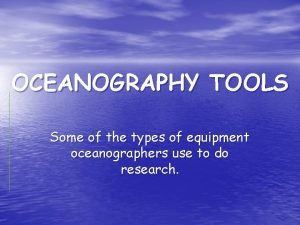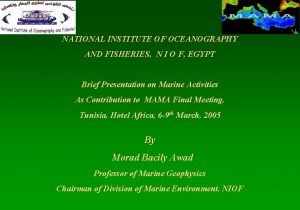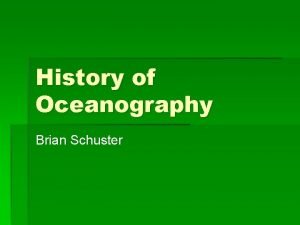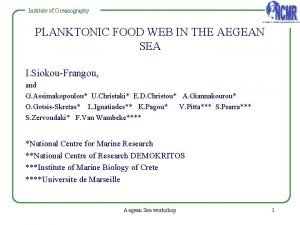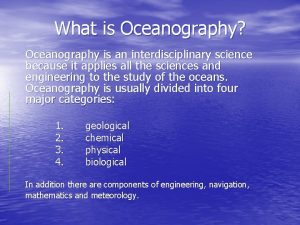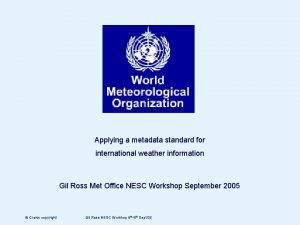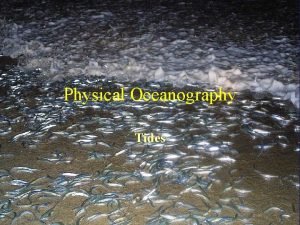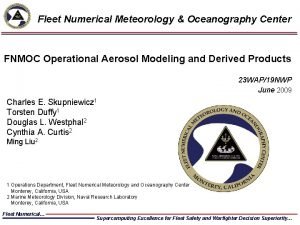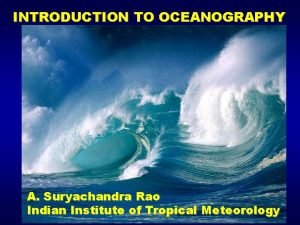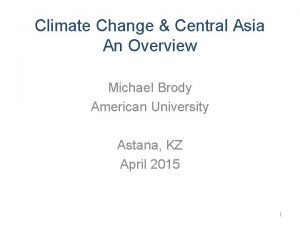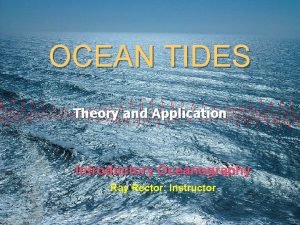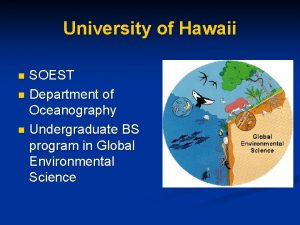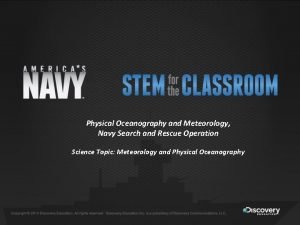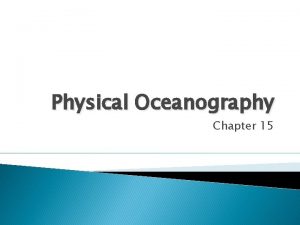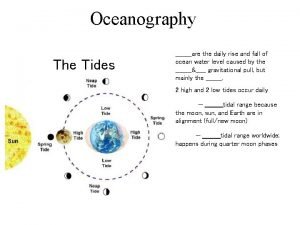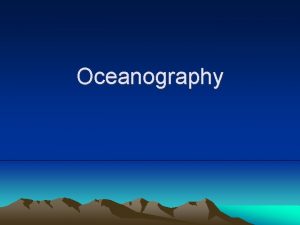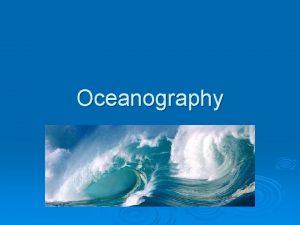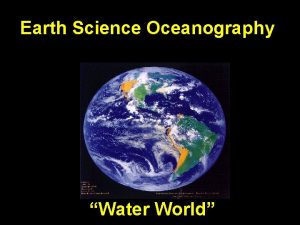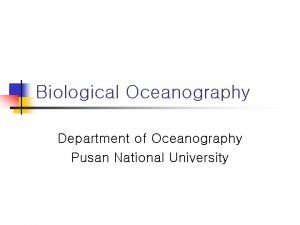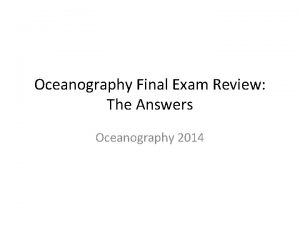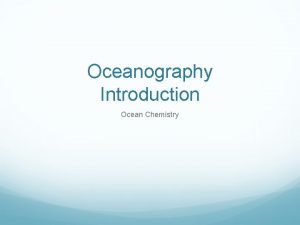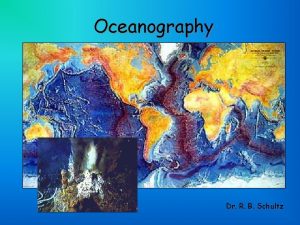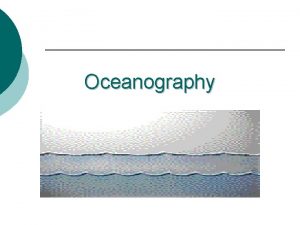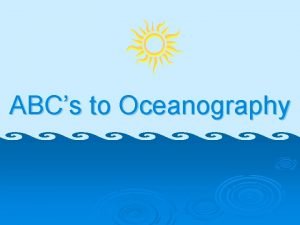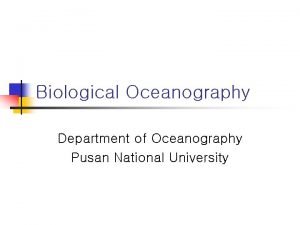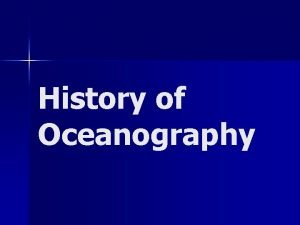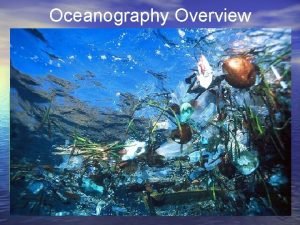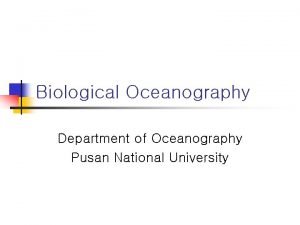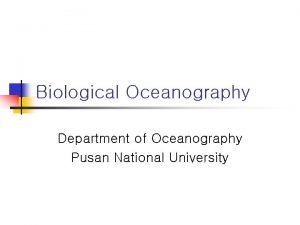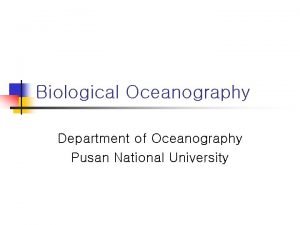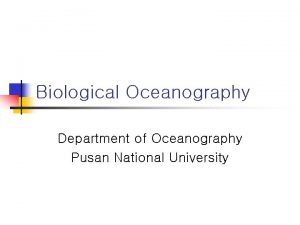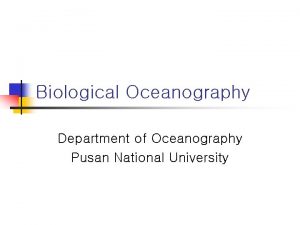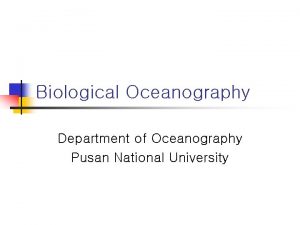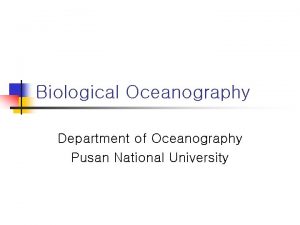OCEANOGRAPHY EarthThe Water Planet The Water Planet of














































- Slides: 46

OCEANOGRAPHY Earth-The Water Planet

The Water Planet § ¾ of earth’s surface covered by a large body of salt water called the global ocean (or hydrosphere) § This hydrosphere contains 97% of all water § 3 major oceans – Atlantic – Pacific – Indian

The Water Planet § Oceans are divided by chemical and physical characteristics § These differences blend near boundaries § Sea- a smaller area of an ocean that is partially surrounded by land

Underwater Exploration § Submersibles- underwater research vessels – Bathysphere – Bathyscaph § Sonar- Sound Navigation And Ranging – Used to map ocean floor and detect submarines § SCUBA- Self-contained Underwater Breathing Apparatus – Developed by Jaques Cousteau



The Ocean Floor • Two major divisions – Continental Margins • Made of continental crust • Thick sediments – Deep Ocean Basins • Made up of oceanic crust • Thin sediments

Continental Margin • The boundary between continental crust and oceanic crust is not the shoreline, but instead occurs many miles offshore deep beneath the ocean.

Continental Margin • Continental Shelf – Gentle slope – Relatively shallow (about 60 m) – Stretch from a few km to 1200 km from shore • Continental Slope – Steeper slope – May reach several thousand meters deep – Thick sediment deposited by rivers

Continental Margin




Deep Ocean Basin • Has all the same physical features as seen on land, such as plains, volcanic mountains, mountain ranges, deep trenches, etc… • However, in the deep ocean basin these features dwarf the similar features on land


Deep Ocean Basins • Trenches – Deepest features on Earth – Located near subduction zones – Mariana Trench • Over 11, 000 m (11 km or 7 miles) deep • Very little is known about the deepest portions

Deep Ocean Basins • Abyssal Plains – Flattest regions on Earth – Depth may change less than 3 m over 1300 km • Seamounts – Submerged volcanic mountains – Form islands when they rise above surface • Guyots – Former volcanic islands that have sunk back under water – Have flat tops, Why?

Deep Ocean Basins • Mid-Ocean Ridge – Formed along a divergent boundary – Longest mountain chains in the world – Magma escapes through rift to form new oceanic crust

Properties of Ocean Water • Chemical Properties – Chemical composition – Dissolved gases – Salinity • Physical Properties – Temperature – Density – Color

Properties of Ocean Water • Chemical Properties – About 96. 5% pure water – Rest is made up of 75 other elements, with Chlorine, Sodium, Sulfate, and Magnesium being the most abundant

Properties of Ocean Water • Chemical Properties continued – Dissolved Gases: nitrogen (N 2), Oxygen (O 2), and carbon dioxide (CO 2) – Temperature affects gas solubility, but not in the way that you might think! • Warm water has less dissolved gases than cold water

Properties of Ocean Water • Chemical Properties continued – Salinity: the ratio of dissolved solids per unit of water – Evaporation and freezing increase the salinity of ocean water – Heavy rain and freshwater runoff will decrease salinity – Salinity tends to be higher near the surface



Properties of Ocean Water • Physical Properties – Water absorbs longer light wavelengths like infrared as opposed to shorter wavelengths like blue and UV rays. – Temperature drops steadily until thermocline, where a rapid temperature drop occurs.

Properties of Ocean Water • Physical Properties continued – Density = mass/volume – Pure water has a density of 1. 00 g/cm 3, ocean water has a density of 1. 028 g/cm 3 – Salinity and Temperature affect density – The colder the water, the more dense it is


Properties of Ocean Water • Physical Properties cont. – Fluids, such as water, exert an upward force on objects that are partially or completely submerged in them. This force is known as buoyant force. – The determination of whether an object sinks or floats is dependent on the object’s density and the fluid density.

Ocean Motion • Ocean water is constantly in motion – Waves – Currents – Tides

Ocean Motion • Waves – A periodic up-and-down movement of the water normally caused by the wind – Tsunami- a seismic sea wave caused by earthquakes on the ocean floor, volcanic eruptions, and/or landslides



Ocean Motion • Ocean Currents – A giant stream or river flowing through an ocean • Surface currents • Deep currents

Ocean Motion • Surface currents are controlled by three factors – Wind belts – Coriolis effect caused by earth’s rotation – Location of the continents


Ocean Motion • Deep currents – Recall that both cold temperatures and high salinity increases the density of water. – In the polar regions, this dense water slowly sinks to the ocean floor causing a slowmoving deep current – The water moves back up to the surface through a process called upwelling

Ocean Motion • Tides – A daily change in the level of the ocean surface due to the gravitational attraction between the Earth and the Moon. – High tides occur on the sides of the Earth nearest the moon and furthest from the moon. Low tides occur half way between the two regions of high tides.


Ocean Resources • Means of Transportation • Food • Fresh Water • Minerals • Oil

Ocean Resources • Food- also called aquaculture – High-protein food using less space and cost than raising livestock on land – Used to raise catfish, salmon, oysters, and shrimp – Kelp: a form of seaweed that is used in many products that we eat today


Ocean Resources • Fresh Water – May become the most valuable ocean resource in the future – Distillation: requires heat – Freezing: requires cold temps – Reverse osmosis: Uses very fine membrane filtration – All three are very expensive BUT are currently in use in arid regions of the world

Ocean Resources • Minerals – Abyssal plains covered with nodules, large lumps of rock and minerals – The nodules contain manganese, iron, copper, nickel, and phosphates – Salt has been retrieved for centuries – Ocean is main source of magnesium and bromine today – Gold?

Ocean Resources • Petroleum – Most valuable mineral resource today – Large deposits of oil and natural gas found beneath the ocean along the continental margins – Almost ¼ of the world’s oil comes from offshore drilling


Ocean Resources • Problems – Ownership – Destruction of ecosystems – Pollution • Garbage • Sewage • Toxic waste • Runoff from land
 Water and water and water water
Water and water and water water Knowledge about earth
Knowledge about earth Chapter 15 physical oceanography
Chapter 15 physical oceanography Oceanography
Oceanography Chemistry oceanography
Chemistry oceanography сплит institute of oceanography and fisheries
сплит institute of oceanography and fisheries Oceanography
Oceanography Chapter 15 physical oceanography
Chapter 15 physical oceanography Chemistry oceanography
Chemistry oceanography Semidiurnal tide
Semidiurnal tide History of oceanography
History of oceanography Oceanography branches
Oceanography branches Earth science chapter 1 vocabulary
Earth science chapter 1 vocabulary Occacaris
Occacaris Dip net oceanography
Dip net oceanography Institute of oceanography and fisheries
Institute of oceanography and fisheries Polynesians oceanography
Polynesians oceanography Oceanography
Oceanography Why is oceanography an interdisciplinary science
Why is oceanography an interdisciplinary science Chemistry oceanography
Chemistry oceanography Essentials of oceanography
Essentials of oceanography Fnmoc
Fnmoc Oceanography
Oceanography Scripps institute of oceanography
Scripps institute of oceanography Neap tide spring tide
Neap tide spring tide University of hawaii soest
University of hawaii soest Search by image
Search by image Chapter 15 physical oceanography
Chapter 15 physical oceanography Oceanography
Oceanography Sự nuôi và dạy con của hươu
Sự nuôi và dạy con của hươu đại từ thay thế
đại từ thay thế Vẽ hình chiếu vuông góc của vật thể sau
Vẽ hình chiếu vuông góc của vật thể sau Cong thức tính động năng
Cong thức tính động năng Thế nào là mạng điện lắp đặt kiểu nổi
Thế nào là mạng điện lắp đặt kiểu nổi Hình ảnh bộ gõ cơ thể búng tay
Hình ảnh bộ gõ cơ thể búng tay Tỉ lệ cơ thể trẻ em
Tỉ lệ cơ thể trẻ em Lời thề hippocrates
Lời thề hippocrates Vẽ hình chiếu đứng bằng cạnh của vật thể
Vẽ hình chiếu đứng bằng cạnh của vật thể độ dài liên kết
độ dài liên kết Quá trình desamine hóa có thể tạo ra
Quá trình desamine hóa có thể tạo ra Các môn thể thao bắt đầu bằng tiếng bóng
Các môn thể thao bắt đầu bằng tiếng bóng Khi nào hổ mẹ dạy hổ con săn mồi
Khi nào hổ mẹ dạy hổ con săn mồi điện thế nghỉ
điện thế nghỉ Dạng đột biến một nhiễm là
Dạng đột biến một nhiễm là Thế nào là sự mỏi cơ
Thế nào là sự mỏi cơ Trời xanh đây là của chúng ta thể thơ
Trời xanh đây là của chúng ta thể thơ Voi kéo gỗ như thế nào
Voi kéo gỗ như thế nào

